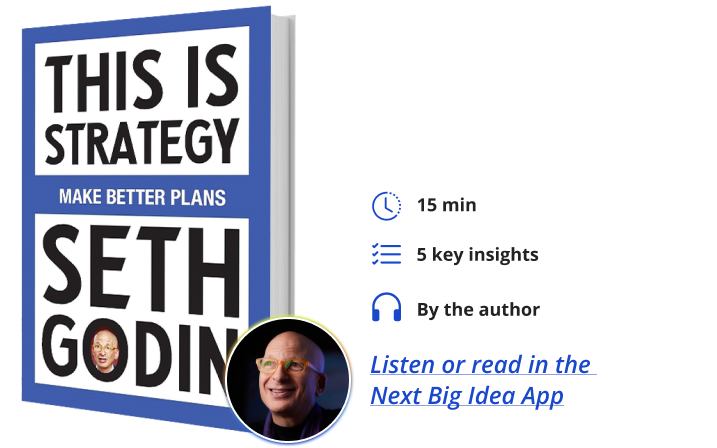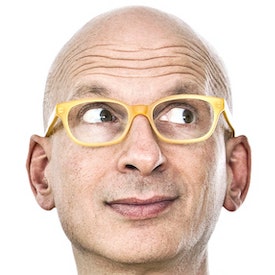Seth Godin is the author of 21 international bestsellers that have changed how people think about work and art. He writes a popular daily blog and has given 5 TED Talks. He is the founder of the altMBA, former VP of Direct Marketing at Yahoo!, and the founder of Yoyodyne.
What’s the big idea?
The status quo has deep, complex defenses that expertly lull the majority into coasting along its path. But what’s better is within reach for people determined to take a hard look at their surroundings and chart a course for change. The best way to propel progress is by strategizing so that the current of existing systems adds momentum in the direction of something new.
Below, Seth shares five key insights from his new book, This Is Strategy: Make Better Plans. Listen to the audio version—read by Seth himself—in the Next Big Idea App.

1. Big problems demand small solutions.
If it’s a big problem, why not have a decree and a giant grand opening and push really hard and solve the thing in one fell swoop? Because if we could, we already would have.
Big problems become big because they’re supported and entrenched by systems. The way we solve them, whether that’s building an organization at scale or addressing some sort of deficiency in our culture, is with something small that grows over time. To do this work of strategy is to have the discipline of finding a philosophy, of becoming, of realizing that we are on a journey in which we take the steps needed to get from here to there.
What we’re looking for when we begin is a compass. It doesn’t matter how fast you’re going, if you’re headed in the wrong direction. Strategy says, What is worth building? What is worth sacrificing today so that we have something in place tomorrow? Too often, too many of us are indoctrinated into simply accepting the status quo instead of realizing that we can make a change happen. We grow a forest by creating the conditions for the trees to grow.
2. Choose your customers. Choose your future.
I met David Chang, the famous chef who is a legend now, before he opened his famous Momofuku restaurant in New York City. Before any of the glowing reviews, he was way down in the East Village, running a diner that was basically empty most of the time. I don’t remember how I found him, but my wife, kids, and I used to drive an hour on Saturdays to have lunch at his counter. I haven’t eaten meat in 30 years, so I ordered the Brussels sprouts without bacon. On the third week of putting in this same order, he turned to me and said, “There’s a vegetarian restaurant a couple of doors down. I think you would like it there better.” Very respectful but very clear. He realized that if they were going to satisfy every person who walked in the door, they weren’t going to become the restaurant they wanted to become.
“Building a strategy involves deciding who it is for and what it is for.”
To do anything that matters, we can’t do it for everyone. If you set out to cater to difficult customers who don’t want to pay a lot and have a short-term turnaround, that’s who you’re going to get. If you set out to find the people who want to go where you are going and are willing to gracefully say “thank you anyway” to those who don’t, now you have a chance to create the work you want.
Building a strategy involves deciding who it is for and what it is for. Who are we here to change? What is the change we seek to make? We can’t possibly do work that matters for everyone. We can only do it for people who care.
3. Strategy is easy to describe and hard to stick with.
Don’t sit around wordsmithing some corporate mission that means nothing. Deeply consider what the bold statement of what you stand for is. Where is the bright line between the things you do and don’t do?
What does it mean to eat at the Union Square Cafe or Gramercy Tavern? It’s very clear their strategy is to say, “We offer hospitality,” because the fact is that the customers they serve already have food at home. People who come to those restaurants for dinner have already eaten lunch and will have breakfast tomorrow. Those restaurants are not solving a food shortage problem. They are changing the affect of those people. Pick your customers, pick your future, figure out where the bright line is, figure out what you stand for, and offer people that very clearly. This is hard to stick with, though easy to describe.
4. Fight to change the status quo.
The status quo is still here because it’s good at sticking around. You’ve got the TV industrial complex, the college industrial complex, and the military-industrial complex, among many other behemoth systems. We need to look at the invisible systems, the subtle systems, the systems that are buried deep in our culture, and decide that we don’t like them anymore and want to change them. We need to see where the status quo is, who is defending it, and how we can leverage it.
Too often we leave strategy to others. We just do our job. Follow the steps. Argue about tactics. I’ve written a bunch of books about making a change happen. Some of them are called “marketing books,” but marketing doesn’t work without strategy.
“We need to see where the status quo is, who is defending it, and how we can leverage it.”
Strategy is a philosophy of becoming the person or organization you hope to be. Strategy has four threads beneath it. It has a lot to do with what we do with scarce resources, the fact that we all don’t play by the same rules, living in a world with outcomes, and time changing the world day by day. When we weave these four threads together, we can see what is possible, be you an individual freelancer or running a giant organization. We all have the same challenge of leveraging how we spend our time on the assets we choose to build.
5. Use the current to propel what matters.
I’m talking to you outside New York City, just off the Hudson River. The Hudson River is a tidal estuary. It flows for 12 hours in one direction and 12 hours in the other one, and it is half salt water. It’s a river, though it looks a bit like a lake from a distance. At first glance, you can’t tell that it’s a river, but you definitely can if you’re on a boat because lakes sit still and rivers have a current. You can fight the current or go with the current. If you want to understand what makes someone a great surfer, it’s that they pick great waves. They can pick the best opportunity and lean into it. It’s the same skill that anyone can use to make a difference.
Are you aware of the current of all the systems around you and where that current is pushing? It may be hard to see at first, but the current exists. Can you take that current and use it to launch a project in a way that helps make a desired change? This isn’t about chasing a fad. It’s about work that matters for people who care, ignoring the others, and using the momentum that river—that system—offers for moving forward.
Better is possible. Not the better of “I get whatever I want,” but the better of “If I do this work in a way that matters, I can make a difference.” This is something we need to talk to each other about: What’s our strategy? What change do we seek to make? Who is it for, and what is it for? You’ve already succeeded, but will you choose to matter? I hope you will.
To listen to the audio version read by author Seth Godin, download the Next Big Idea App today:






























